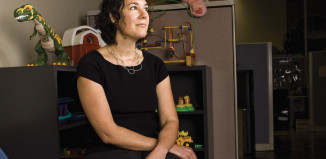Several years ago, when artist Jaclyn Pryor was a graduate student at the University of Texas, she grappled mightily with a performance art piece called “Floodlines,” which she had been working on for more than a year, an undertaking that originated as her master’s thesis project. After developing an idea for a performance influenced by the tragic events of Sept. 11, 2001, and the death of her grandmother, as well as how people cope with trauma, understand time and access memories, Pryor spent hours toiling over the project’s script, but was still unhappy with the outcome. There was something missing.
Set to perform a segment of the piece in front of an audience at the campus Union, Pryor started to panic when she realized she had no access to a shower, a necessity considering Pryor performs dressed in a sopping-wet black suit. So, donning her best funeral attire and with only minutes until she was to present her piece, Pryor bolted from the Union Building in search of the closest campus shower. Instead, she found a nearby fountain and, to the amazement of many an onlooker, leapt into the water. Sloshing out of the fountain, her suit drenched and dripping, Pryor broke in to a full run, holding a tiny American flag prop away from her body so it wouldn’t get soaked.
 In the midst of her lunatic scurry back to the Union, Pryor noticed bystanders staring intently, and, suddenly, inspiration struck her.
In the midst of her lunatic scurry back to the Union, Pryor noticed bystanders staring intently, and, suddenly, inspiration struck her.
“I thought, ‘This is the performance,’” she declares. “This is what I was having so much trouble defining on paper. With me running along and people following me, there was a new energy to the piece. But I remember thinking, ‘If I’m running, where’s the audience going to be? Well, maybe they’re in cars, moving along in a funeral procession.’”
This funeral procession would become the performance’s “container,” the glue that holds it all together and allows Pryor to focus the audience’s attention in certain areas and control their overall aesthetic and emotional experience.
After months of effort and struggle, “Floodlines” was becoming actuality, and all it took was a harried, unexpected jaunt across campus for the idea to solidify in Pryor’s mind.
“I guess I function well in pressure situations,” she says, laughing. “When I have less time to make decisions, I make quicker decisions that come from within and I don’t second-guess them.”
Since then, “Floodlines,” has become an artistic success, and is now in its fifth year. The performance, a site-specific art installation which takes place once a year in Austin’s Hyde Park neighborhood, is much more three-dimensional interactive ceremony than basic theatrical play. The audience literally follows Pryor and a cast of dozens along tree-lined streets and neighborhood lawns for several miles as the performers act out scenes inspired by the ideas of absence, loss, ghosts and the traditions involved in Judaism, the religion on which Pryor was raised.
THE INSPIRATION OF HISTORY
Growing up in the Jewish-immigrant-rich suburbs of Chicago, Pryor was exposed to generations of compelling and often trying family history. Her father, whose own parents were Holocaust survivors, was born in post-war Germany and later immigrated to America. Her mother’s mother had come to America from Poland, and Pryor says growing up, her own life was often informed by her family’s concept of the “new American experience.”
“Something I keep coming back to in my thread of work is history and memory. One of the things that is probably fundamental to my work is my family history,” Pryor explains. “When I was growing up, I loved looking at old family photographs. As an artist, those kinds of pictures have taught me how to think simply about complex ideas. I think it’s important for an audience to be able to project their own stories on to a project, so I try to conceive of projects that are really powerful but that people can still relate to.”
Like many artists, Pryor happened upon her talent almost accidentally. While attending Washington University in St. Louis, she decided she would study the French language, and even participated in a study-abroad program in France. Pryor’s desire for knowledge was unquenchable; she read thousands of books and immersed herself in literature, women’s studies, philosophy, politics and history. But as she traveled across the European continent, she became enchanted with a new love: theater, a discipline she says has influenced her artwork and made her more sensitive to the fundamentals of narration.
“I didn’t have much exposure to or experience with other types of art. Growing up, I didn’t think I was a very good drawer, which was my idea of art at the time,” Pryor recalls. “But theater really spoke to me in an emotional kind of way.”
By her senior year of college, Pryor had become entrenched in performing arts, often directing or acting in stage plays. Her dedication was elevated to a new level when lesbian director Anne Bogart – founder of the acclaimed SITI Co. ensemble-based theater company in New York – came to Pryor’s school for a two-month residency.
“It was amazing working with Anne,” Pryor says. “We did a lot of physical training. I used my body so much that I felt like a dancer, and that really opened up my mind to different ways of working with my body. I found ways to tell stories that weren’t text-based. And that was the first time I really felt like an artist.”
Learning the particulars of the theater world has helped Pryor develop in to a vanguard performance artist. (Check out her website for more specifics: www.JaclynPryor.com.)
“I feel that I’ve found my discipline, but I don’t think I would have come to it without theater. Theater privileges the audience, and just thinking about their experience has trained me to think about the audience’s perception, the story, space, time and other things that I might not be attuned to otherwise,” Pryor expresses.
A LITTLE DOUGH GOES A LONG WAY
After graduating with a bachelor’s degree in performing arts and spending some time sharpening her artistic craft in New York City and Chicago, Pryor moved to Austin in 2002. She received a master’s degree in performance as public practice from UT, the site of her aforementioned “Floodlines” awakening.
Once “Floodlines” became an annual occurrence, the performance was viewed by First Night Austin’s executive director at the time, Ann Graham, who was so taken by the piece that she commissioned a new project from Pryor for the upcoming 2006 First Night event, a public celebration of the arts in which the entire downtown city becomes a canvas.
 “Jaclyn is such an artist,” Graham says. “From the first time I met her, I was intrigued with the tangent of thinking, her clear-mindedness about what she wanted to achieve, but also her willingness to approach ideas from different angles.”
“Jaclyn is such an artist,” Graham says. “From the first time I met her, I was intrigued with the tangent of thinking, her clear-mindedness about what she wanted to achieve, but also her willingness to approach ideas from different angles.”
Again influenced by Jewish traditions, particularly those surrounding the celebration of the new year, Pryor devised an idea for a public art project involving bread. But without a venue, Pryor, a site-specific artist, struggled with how to complete the piece. However, the pressure to develop the concept once again led to its success. With the help of Texas French Bread and a few dozen volunteers, Pryor packaged and delivered 2,006 freshly baked loaves of sourdough bread to households throughout Austin on the morning of Dec. 31, 2005, a concept Graham calls “a stroke of genius.” Those lucky enough to awake with a loaf on their doorsteps were invited to bring their bread downtown and participate in First Night Austin’s Grand Processional, a parade that culminated with “Bread” participants releasing crumbs into Town Lake and making a resolution for the new year.
“A few hundred people showed up for ‘Bread,’ and as time went on, I started to realize that I love making art with people who aren’t artists,” Pryor says. “I didn’t start out doing community work. I just started with artwork in public places and it developed in to art with the community. I just love accidental audiences, and ‘Bread’ proved that community art could actually engage a lot of people.”
LOVE ON THE LINE
The following year, as First Night Austin was preparing for the 2007 event, Graham approached Pryor with the idea of another “Bread” project. But ready for something different, Pryor developed a concept based on color.
“I wanted to do something with pink, and I kept coming back to the idea of painting mailboxes pink, but that wasn’t going to work,” she says. “I was attracted to doing something that was viral and would grow over time. And I was really attracted to old-fashioned modes of communication, and the aesthetics of bicycles and wheels. Then the idea all came together at once.”
“Pink,” a love courier service, would become an art installation in which the labor – the behind-the-scenes effort – was exposed for the audience. Pryor and her band of volunteers converted an empty storefront on West Second Street into a blushing, Willy Wonka-esque “factory,” complete with an assembly line, a reception desk and a couriers’ uniform rack where overalls emblazoned with “Pink” patches were stored. The audience was encouraged to enter the space and, with the help of a poet-on-call, craft individualized love notes on tiny rose-colored sheets of paper, which were then attached to a clothesline.
Volunteers would holler, “Love on the line,” as they sent the love notes careening down the clothesline to the facility’s bottling operation, where they were beautifully packaged and adorned with the message, “You are loved.” Bicycle couriers then delivered each bottle to surprised and delighted recipients all over Austin.
Though Pryor admits the project was a logistical nightmare from the get-go, she beseeched a group of “Pink” volunteers to embrace this unusual experiment.
“I like art projects that are logistical nightmares because one of the things that’s spectacular for the audience is sort of how it all worked and the fact that it worked,” Pryor conveyed to her volunteers, adding, “I’ve never done something that didn’t work, so this will likely work.”
And work it did. The First Night Austin “Pink” project was such a success that months later Pryor took the work to Portland, Ore., where volunteers clamored to be a part of the love fest.
THE ONCE AND FUTURE ARTIST
Pryor is constantly developing ideas for new art projects. One she’s been contemplating involves militarized students, and how war and education make strange bed- fellows. But that concept will have to remain just that for the time being, as Pryor is currently absorbed in “Pink.”
A production of “Pink” heads to Chicago this summer, a venture that Pryor says is somewhat scary, as it will be independently produced and presents many logistical challenges. However, these are hurdles Pryor says she’ll have to overcome since she plans to eventually take “Pink” on tour, a huge undertaking that she hopes can become a sustainable venture.
While she’s not traveling, Pryor is comfortable and happy living in Austin, and says she plans to stay in the Capital City for some time. Her partner and a great sup- port system are here. She’s thrilled to receive local sponsorship in the form of arts grants, and thoroughly enjoys the two days a week she teaches writing to adults through the Humanities Institute’s Free Minds Project at UT.
Pryor finds artistic inspiration everywhere: in the streets of a bustling downtown district, on a bike ride through the wilderness, in the eyes of her grateful students, and among the memories of her childhood.
Quite simply, for Pryor, life is art. But there’s no mistaking that she’s the masterpiece.




































